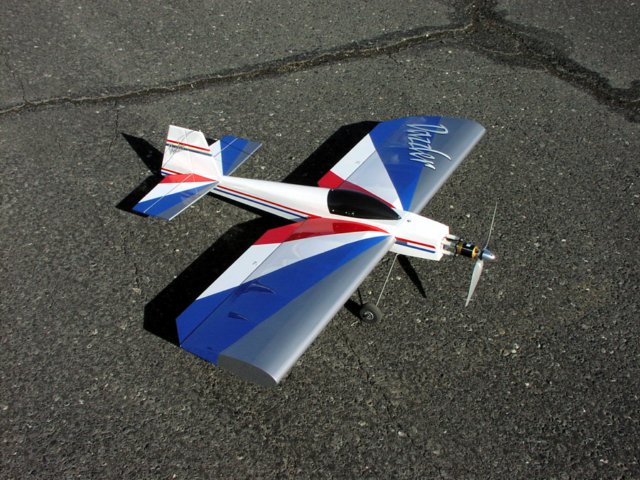Great Planes Dazzler
| READY!! |
General Specifications
Build Date - August 2004
| Airframe Type - | Mid (FAT) Wing | Flying Type - | Sport Aerobatic | |
| Wingspan = | 48 inches | Length = | 43 inches | |
| Wing Area = | 578 sq. inches | All-Up Weight = | 66 ounces | |
| Motor - | Turnigy SK4240-750 | Wing Load = | 16.4 oz/sq. ft. | |
| Propeller - | 14 x 7 APCe | Power = | 685 watts | |
| Thrust = | 103 ounces | Thrust/Weight = | 1.56 | |
| Battery Type - | Lipoly 4S1P | Capacity = | 3300 mah | |
| Speed Control - | Turnigy 60 Amp | BEC - | 8 Amp external |
Image Gallery
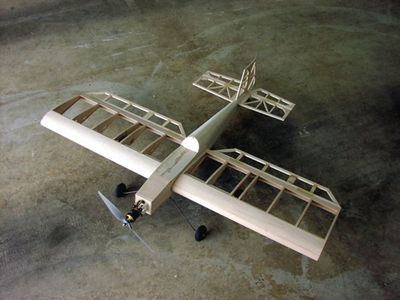 | |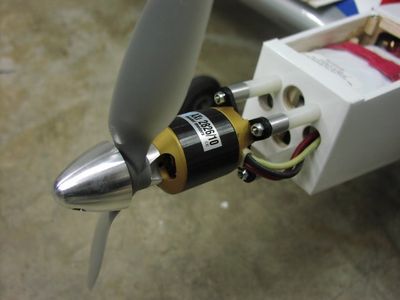 | |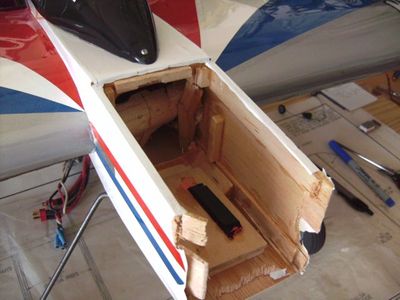
|
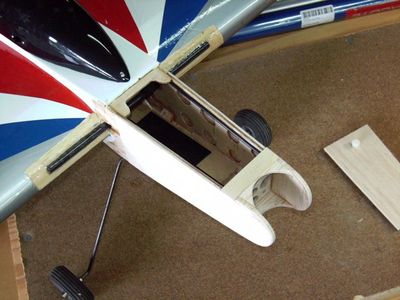 | |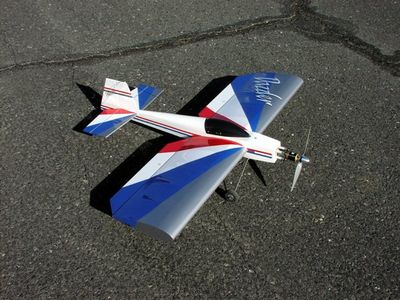 | |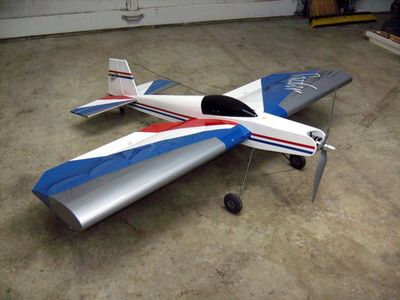
|
Commentary
The Dazzler was bought on a whim (as are most!). I had seen a similar plane at my local flying field and the pilot was very good at showing off the capabilities of a fat, mid wing flyer. What I didn't know at the time was how heavy this airframe would be or how difficult it was going to be to get the CG correct. I also didn't see how limited the space was for batteries.
The motor I had selected was the AXI 2826/10 which made the battery problem worse when I found, on the bench test, how much power this motor would need. The batteries I had selected were by Tanic and configured as 4S2P 4400mah, 15C pack and they were barely sufficient to run the set-up. I selected these in particular because they were inexpensive (~$100/Pack) and they were sized such that they should fit the very short fuel tank space in this airframe. The only other choices at the time were much more expensive (~$220) Thunder Power packs.
I built the airframe as per the original design without removing any weight or design elements. When completely finished I was a little disappointed at the overall weight and the fact I had to add both a heavy solid aluminum spinner and nearly 3 ounces of ballast to get the CG at the recommended location.
The maiden and subsequent first four flights were a little surprising. First the AXI motor pulled like a monster! This is both good and bad as the real surprise was how the plane literally jumped off the runway and then flew very strangely due to the fact the motor needed and additional 2.5 degrees of down thrust and 2 degrees additional right thrust. Still, it was fun to fly something with this kind of power. Another very nice feature was how well it handled wind. Far better than any other plane I had at the time. So my hopes were up that I could yet get much more performance with some tweeks here and there.
The next rounds of flights had the thrusts dialed in well, the CG moved aft a bit (which also allowed a small weight reduction) and some trim work. The plane was now very well behaved, easy to fly and even easier to land. The other pilots at my field were very impressed with the plane as it was one of the first at this field with real, wet-like performance. I did still have a couple of disappointments in the planes ability to do 3D (It really couldn't), the all up weight and the fact the batteries were done in about 6 minutes. At the time there was very little selection in battery sizing.
Roll forward a few years...
Apparently, I didn't get a lot of pleasure out of this plane because in retrospect, I didn't take it out that much. After a few years had passed however, the availability of less expensive Motors and Lipolys led me to re-think this plane a bit. I bought a lower Kv motor and much better batteries (30C) which together allowed a larger diameter, lower pitch Prop. Of course I was still trying to get some 3D flight characteristics and this did improve. The plane however was still rather heavy and it flew that way.
Then CRASH! (2010). One of my dumber moves because this crash was a result of a lack of pre-flight checks. I had by this time converted the entire air force to 2.4Ghz radio technology except this one plane. The pre-flight check I missed was a simple one, I failed to extend the antenna an my JR 72Mhz transmitter. All the new 2.4Ghz gear has no antenna to extend so I simply forgot this very important check. The crash came quickly. I took off and immediately noticed almost a complete lack of any control and the plane, under nearly full power simply dove straight down and augured in. The result was the front of the fuselage including the center 5 inches of the leading edge was destroyed. Due to this planes robust construction however, nothing else was damaged so at least I knew it could be rebuilt.
On rebuild I deviated a little from the original plan and added about 2 inches of fuselage box to the front which eliminated the need for motor mount stand-offs (extensions). This gave me significantly more battery room with the additional benefit of being able to move the battery weight forward and get rid of the heavy spinner and all of the ballast weight. I also added fuselage sides around the motor to hide it a little and I think overall the plane looks much better. With this new set-up, the plane flies much better, noticeably more nimble and will do some level of 3D manuevering.
The next round of mods I have planned for this bird are to re-hinge all the control surfaces to get more deflection, add some area to the elevator and rudder and change the extremely slow (.28 sec @4.8v) JR servos for some that are more in line with high performance servos of today. I will likely strip the covering off of the wing and work on some lightening as well. I am confident I can get 6+ ounces out of this airframe without losing any structural integrity.
That's all for now, stay tuned...
- Buy recommendation - Yes! (if still available)
- Build skill - Intermediate (Wood stick kit) Do the front end mods if you choose electric conversion.
- Pilot skill - Intermediate (Flat wing sport)
- Lesson learned - Don't shortcut pre-flight checks!
